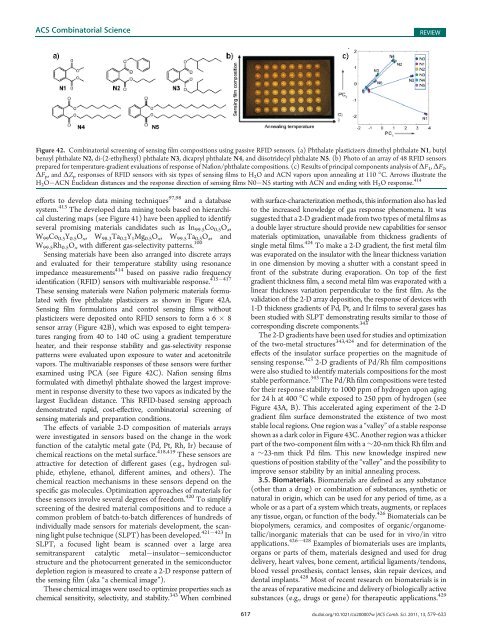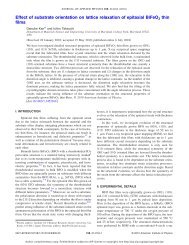Combinatorial and High-Throughput Screening of Materials ...
Combinatorial and High-Throughput Screening of Materials ...
Combinatorial and High-Throughput Screening of Materials ...
You also want an ePaper? Increase the reach of your titles
YUMPU automatically turns print PDFs into web optimized ePapers that Google loves.
ACS <strong>Combinatorial</strong> Science<br />
REVIEW<br />
Figure 42. <strong>Combinatorial</strong> screening <strong>of</strong> sensing film compositions using passive RFID sensors. (a) Phthalate plasticizers dimethyl phthalate N1, butyl<br />
benzyl phthalate N2, di-(2-ethylhexyl) phthalate N3, dicapryl phthalate N4, <strong>and</strong> diisotridecyl phthalate N5. (b) Photo <strong>of</strong> an array <strong>of</strong> 48 RFID sensors<br />
prepared for temperature-gradient evaluations <strong>of</strong> response <strong>of</strong> Nafion/phthalate compositions. (c) Results <strong>of</strong> principal components analysis <strong>of</strong> ΔF 1 , ΔF 2 ,<br />
ΔF p , <strong>and</strong> ΔZ p responses <strong>of</strong> RFID sensors with six types <strong>of</strong> sensing films to H 2 O <strong>and</strong> ACN vapors upon annealing at 110 °C. Arrows illustrate the<br />
H 2 O ACN Euclidean distances <strong>and</strong> the response direction <strong>of</strong> sensing films N0 N5 starting with ACN <strong>and</strong> ending with H 2 O response. 414<br />
efforts to develop data mining techniques 97,98 <strong>and</strong> a database<br />
system. 413 The developed data mining tools based on hierarchical<br />
clustering maps (see Figure 41) have been applied to identify<br />
several promising materials c<strong>and</strong>idates such as In 99.5 Co 0.5 O x ,<br />
W 99 Co 0.5 Y 0.5 O x , W 98.3 Ta 0.2 Y 1 Mg 0.5 O x , W 99.5 Ta 0.5 O x , <strong>and</strong><br />
W 99.5 Rh 0.5 O x with different gas-selectivity patterns. 100<br />
Sensing materials have been also arranged into discrete arrays<br />
<strong>and</strong> evaluated for their temperature stability using resonance<br />
impedance measurements 414 based on passive radio frequency<br />
415 417<br />
identification (RFID) sensors with multivariable response.<br />
These sensing materials were Nafion polymeric materials formulated<br />
with five phthalate plasticizers as shown in Figure 42A.<br />
Sensing film formulations <strong>and</strong> control sensing films without<br />
plasticizers were deposited onto RFID sensors to form a 6 8<br />
sensor array (Figure 42B), which was exposed to eight temperatures<br />
ranging from 40 to 140 oC using a gradient temperature<br />
heater, <strong>and</strong> their response stability <strong>and</strong> gas-selectivity response<br />
patterns were evaluated upon exposure to water <strong>and</strong> acetonitrile<br />
vapors. The multivariable responses <strong>of</strong> these sensors were further<br />
examined using PCA (see Figure 42C). Nafion sensing films<br />
formulated with dimethyl phthalate showed the largest improvement<br />
in response diversity to these two vapors as indicated by the<br />
largest Euclidean distance. This RFID-based sensing approach<br />
demonstrated rapid, cost-effective, combinatorial screening <strong>of</strong><br />
sensing materials <strong>and</strong> preparation conditions.<br />
The effects <strong>of</strong> variable 2-D composition <strong>of</strong> materials arrays<br />
were investigated in sensors based on the change in the work<br />
function <strong>of</strong> the catalytic metal gate (Pd, Pt, Rh, Ir) because <strong>of</strong><br />
chemical reactions on the metal surface. 418,419 These sensors are<br />
attractive for detection <strong>of</strong> different gases (e.g., hydrogen sulphide,<br />
ethylene, ethanol, different amines, <strong>and</strong> others). The<br />
chemical reaction mechanisms in these sensors depend on the<br />
specific gas molecules. Optimization approaches <strong>of</strong> materials for<br />
these sensors involve several degrees <strong>of</strong> freedom. 420 To simplify<br />
screening <strong>of</strong> the desired material compositions <strong>and</strong> to reduce a<br />
common problem <strong>of</strong> batch-to-batch differences <strong>of</strong> hundreds <strong>of</strong><br />
individually made sensors for materials development, the scanning<br />
light pulse technique (SLPT) has been developed. 421 423 In<br />
SLPT, a focused light beam is scanned over a large area<br />
semitransparent catalytic metal insulator semiconductor<br />
structure <strong>and</strong> the photocurrent generated in the semiconductor<br />
depletion region is measured to create a 2-D response pattern <strong>of</strong><br />
the sensing film (aka “a chemical image”).<br />
These chemical images were used to optimize properties such as<br />
chemical sensitivity, selectivity, <strong>and</strong> stability. 343 When combined<br />
with surface-characterization methods, this information also has led<br />
to the increased knowledge <strong>of</strong> gas response phenomena. It was<br />
suggested that a 2-D gradient made from two types <strong>of</strong> metal films as<br />
a double layer structure should provide new capabilities for sensor<br />
materials optimization, unavailable from thickness gradients <strong>of</strong><br />
single metal films. 424 To make a 2-D gradient, the first metal film<br />
was evaporated on the insulator with the linear thickness variation<br />
in one dimension by moving a shutter with a constant speed in<br />
front <strong>of</strong> the substrate during evaporation. On top <strong>of</strong> the first<br />
gradient thickness film, a second metal film was evaporated with a<br />
linear thickness variation perpendicular to the first film. As the<br />
validation <strong>of</strong> the 2-D array deposition, the response <strong>of</strong> devices with<br />
1-D thickness gradients <strong>of</strong> Pd, Pt, <strong>and</strong> Ir films to several gases has<br />
been studied with SLPT demonstrating results similar to those <strong>of</strong><br />
corresponding discrete components. 343<br />
The 2-D gradients have been used for studies <strong>and</strong> optimization<br />
<strong>of</strong> the two-metal structures 343,424 <strong>and</strong> for determination <strong>of</strong> the<br />
effects <strong>of</strong> the insulator surface properties on the magnitude <strong>of</strong><br />
sensing response. 425 2-D gradients <strong>of</strong> Pd/Rh film compositions<br />
were also studied to identify materials compositions for the most<br />
stable performance. 343 The Pd/Rh film compositions were tested<br />
for their response stability to 1000 ppm <strong>of</strong> hydrogen upon aging<br />
for 24 h at 400 °C while exposed to 250 ppm <strong>of</strong> hydrogen (see<br />
Figure 43A, B). This accelerated aging experiment <strong>of</strong> the 2-D<br />
gradient film surface demonstrated the existence <strong>of</strong> two most<br />
stable local regions. One region was a “valley” <strong>of</strong> a stable response<br />
shown as a dark color in Figure 43C. Another region was a thicker<br />
part <strong>of</strong> the two-component film with a ∼20-nm thick Rh film <strong>and</strong><br />
a ∼23-nm thick Pd film. This new knowledge inspired new<br />
questions <strong>of</strong> position stability <strong>of</strong> the “valley” <strong>and</strong> the possibility to<br />
improve sensor stability by an initial annealing process.<br />
3.5. Biomaterials. Biomaterials are defined as any substance<br />
(other than a drug) or combination <strong>of</strong> substances, synthetic or<br />
natural in origin, which can be used for any period <strong>of</strong> time, as a<br />
whole or as a part <strong>of</strong> a system which treats, augments, or replaces<br />
any tissue, organ, or function <strong>of</strong> the body. 426 Biomaterials can be<br />
biopolymers, ceramics, <strong>and</strong> composites <strong>of</strong> organic/organometallic/inorganic<br />
materials that can be used for in vivo/in vitro<br />
applications. 426 428 Examples <strong>of</strong> biomaterials uses are implants,<br />
organs or parts <strong>of</strong> them, materials designed <strong>and</strong> used for drug<br />
delivery, heart valves, bone cement, artificial ligaments/tendons,<br />
blood vessel prosthesis, contact lenses, skin repair devices, <strong>and</strong><br />
dental implants. 428 Most <strong>of</strong> recent research on biomaterials is in<br />
the areas <strong>of</strong> reparative medicine <strong>and</strong> delivery <strong>of</strong> biologically active<br />
substances (e.g., drugs or gene) for therapeutic applications. 429<br />
617 dx.doi.org/10.1021/co200007w |ACS Comb. Sci. 2011, 13, 579–633












